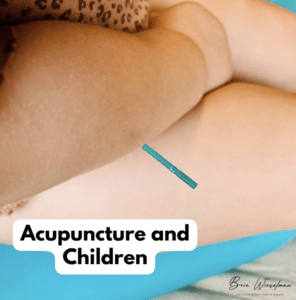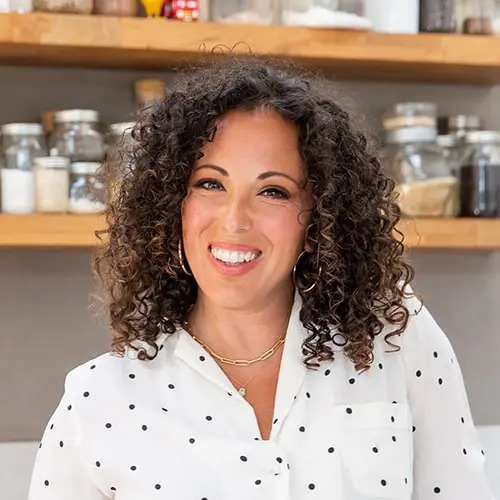I’m a gut health expert, who has done everything “right”… and my toddler daughter has been struggling with constipation!
Yes, it feels a little vulnerable to tell you this, but above all else I want to always be honest.
So here’s the honest truth: no matter how hard we try to care for ourselves and the ones we love, sometimes health issues still present themselves. When they do, we have two choices. We can either bury our head in the sand and wish it wasn’t so, or meet the challenge head on.
So today let’s dig into constipation in kids: what causes it, and how we can help. Plus, I’ll share my own story of helping my daughter through this health challenge.
My Daughter’s Constipation Story
From the time I found out I was pregnant, I did everything I could to set my daughter up for a lifetime of gut health. I used oral and vaginal probiotics leading up to her birth, and pushed for a vaginal delivery (even though I had a lot of pressure for a C-section). When she was born, I gave her probiotics on my nipple, and later in bottles of breastmilk.
We waited to introduce solids until she was a little over 6 months, and then introduced them according to the book Super Nutrition for Babies, which is based on the work of Dr. Weston A. price and heavily influenced by the paleo diet. Her first foods were all high-fat, breast milk-mimicking foods like puréed liver and broth, egg yolk from a very softly boiled egg, puréed fish and lamb, and avocado.
And it seemed to really work: by eight months old, she was downing a cup of broccoli at a time. She loved tasting new food – sauerkraut, pickles, curry, and all the veggies.
But then, after a family vacation to Mexico and a bout of food poisoning, something seemed to change. Suddenly, her belly was protruding more than it had before, and she was skipping multiple days between bowel movements. When she did go, she sometimes cried and complained it hurt. Her diet hadn’t changed – so I couldn’t blame too many crackers and cookies, or low fiber intake. It was something deeper than just diet.
As a functional medicine practitioner, I had some hunches as to what was going on – and I’ll share exactly what I did to get her back to daily poops at the end of this post.
But first, let’s dive into constipation in children: why, what, and how we can help.
Signs of Constipation in Kids
Depending on the age of your child, they may not be able to communicate that they’re feeling backed up. That’s why it’s important for parents to keep an eye on things. (And even kids that are verbal may not connect that their tummy hurts because they haven’t been pooping!)
Here are signs of constipation, based on age:
Babies
Constipation is most common in babies during transitions – either from breastmilk to formula, or with the introduction of solids. If a baby is exclusively being fed breastmilk or formula and has constipation, that’s a red flag for a bigger issue, most commonly food sensitivities.
Signs of constipation include going 4+ days without a bowel movement, less frequent bowel movements than normal, crying while passing stools, dry or pebble-like stool, or struggling/straining while pooping.
Toddlers
Normal is considered anywhere from daily to once every 3 days, but sudden changes are a red flag – like if your usual daily pooper has gone 3 days without going. Older toddlers might tell you their tummy hurts, or that it hurts to poop. You might also notice that their stomach pokes out more than usual, and that it’s hard to the touch. Bowel movements might be difficult to pass or unusually large. The stool may seem to move out and then back in before they can successfully pass it.
Because pooping is painful when they’re constipated, toddlers might also start to hold their poop and avoid going. This only makes the problem worse, so it’s ideal to jump in right away with some of the solutions I’ll outline here, before they start holding their bowel movements in.
Foods That Cause Constipation in Children
Not enough fiber is the most common food-related cause of constipation. Your child’s age + 5 = the number of grams of fiber they should be consuming each day. The exception are babies under six months of age: they have no need for food besides breastmilk or formula. If you’ve introduced solids before six months and your baby is struggling with constipation, stop feeding them – especially if you started with rice cereal or something similar!
Hand-in-hand with not enough fiber goes too many high-starch foods like crackers, cookies, pasta, bread, etc.
Food intolerances, most commonly to cow dairy and wheat or gluten, are another common food-related cause of constipation. Many kids transition from breastmilk or formula straight to cow’s milk, which for many, is the primary cause of constipation. Wheat is also hard to digest and can be constipating for some children. Separately, they may also have gluten intolerance, where gluten exposure causes inflammation and various GI symptoms.
Foods to Help Constipation in Children
In general, kids should be on a Paleo-template diet that emphasizes lots of whole foods, in whole form, the majority of the time. (If your kids are eating this way, you likely don’t need to worry about fiber). There is always room for “excursions” from the diet for special occasions, but those excursions should remain excursions, and not become part of the everyday way of eating.
If you need to overhaul the way your kids are eating, do it slowly and keep them involved. It’s great to have kids in the kitchen, helping you cook. And don’t forget you can blend veggies into all sorts of things! (I’ve included one of my favorite high-fiber, veggie packed recipes for kids at the bottom of this post!)
Adding in these foods to help constipation in children is especially beneficial:
Sugar free water kefir with chia seeds – provides hydration and beneficial wild probiotic strains, adding chia not only helps moisten the intestine, but makes it more fun for kids to eat
Fermented veggies – more beneficial bacteria and fiber. You might think your kid would never eat them, but you would be surprised how many toddlers and babies love them, especially fermented beets!
High fiber foods – strawberries, apples, pears, prunes, bananas, avocado, beets, blueberries, raspberries, broccoli, chickpeas, lentils, black beans, pumpkin, peas, spinach, and sweet potatoes are some of my favorites.
What about oats? While oats get a ton of buzz for being high-fiber, I find that many children have a very hard time digesting grains. Grains contain lectins and phytates, two anti-nutrients that can cause leaky gut. I don’t recommend emphasizing grains, and instead focusing on other high-fiber foods.
Finally, make sure your kids are well hydrated! Babies over 6 months can have 2-3 ounces of water, a few times daily (and will get the majority of their hydration from breastmilk or formula). Toddlers should be drinking 16-32 ounces of liquids daily, with the majority being water, not milk, milk substitutes, or juice.
If your child refuses to drink enough water, soaking fruit in water in the fridge overnight can add some flavor, as can a splash of something flavorful such as the low-sugar Kefir Water drink mentioned above, or coconut water.
What Else Causes Constipation?
If diet has already been addressed and constipation isn’t improving, it’s time to dig a little deeper. Some of the other causes of constipation I commonly see in children include parasites, H pylori, Candida overgrowth, and Small Intestine Bacterial Overgrowth (SIBO).
Kids touch… everything! And they constantly put their hands in their mouths, making them prime candidates for parasites and pathogens. Plus, their immune systems aren’t yet fully mature, making them more susceptible to things like foodborne illness or parasites in water. (Water can be contaminated when traveling – but even city and well water can become constmainted. That’s why we use a Berkey water filter.)
Acute GI infections, such as food poisoning, can also lead to a condition called Post-Infectious Irritable Bowel Syndrome, better known as Small Intestine Bacterial Overgrowth (SIBO). Learn more about SIBO here..
All of these issues can be diagnosed via stool panels and treated naturally with child-specific herbal protocols. (As a mom, I know how hard it is to get kids to take anything yucky-tasting… so I worked hard to find a treatment plan kids would actually take!)
If your child is old enough to blow into a tube, we can also run a SIBO breath test, but in kids I find treating dysbiosis more generally based on stool panels alone is typically adequate (and saves you money and time, too!)
Constipation Relief Supplements
In addition to diet, specific supplements can make a huge difference in kids’ constipation.
Herbs: I prefer gentle carminative herbs (gas-relieving) over laxatives, because laxatives can be habit-forming (even herbal ones!) That being said, I prefer herbal laxatives over Miralax any day!
Why I Don’t Recommend Miralax
Miralax is often a first line of defense against constipation in kids, but for several reasons, I don’t like it, including that it contains red dye, hasn’t been approved for use in kids or long-term use by the FDA, and is associated with ADHD and other mood/behavior disorders. It can often be habit-forming, and leave kids dependent on it to poop. There are lots of herbal alternatives that work just as well, without these concerns.
Pre- and Probiotics: Probiotics are the good bacteria that live in the gut, and prebiotics are the food probiotics need to thrive. I recommend MegaSporeBiotic (which i use at ¼-½ the adult dosage of 2 caps per day, depending on the child’s weight) and MegaPre prebiotic (2 caps per day, which is ⅓ adult dosage). If you want to try a prebiotic option, I recommend Begin Health Growing up Prebiotics that use human milk oligosaccharides, which are identical to the most abundant prebiotic naturally found in breastmilk [plus get 20% off first purchase with my code: BRIE20].
Magnesium: This mineral can help bring water to the bowels. I use Mag-Go kids.
Try These Tricks to Help Ease Constipation
In addition to diet and supplements, there are a few other tricks to try:
Drink this: For quick relief, I like ¼-⅓ cup aloe vera juice and 1 teaspoon to 1 tablespoon of liquid chlorophyll, 3x daily.
Massage: I use Chinese medicine tuina techniques with oil, followed by raising the knees up to the right and then around clockwise in a circle. Repeat this several times a week for about 10 minutes. Below is another massage location for constipation in children, on the hand. Start at the base of the thumb and work in a clockwise direction, pressing and releasing along the circle.
Get into position: Giving kids a place to rest or elevate their feet while pooping puts them into an ideal posture for pooping. This makes a big difference. I like the Squatty Potty for Toddlers or Super Pooper Plus.
Make time to go every day: Kids are busy moving from activity to activity – and sometimes when the urge to go comes on, they’d rather ignore it than stop what they are doing. That’s why I recommend creating a habit of trying to poop at roughly the same time every day. (If you notice they have a time they most often poop, like after lunch, that’s a good time to try!) Just keep it light hearted: go sit on the toilet, read a book or sing a song, and don’t make a big deal out of it. If they don’t poop, NBD. It’s about building a habit.
Putting The Plan Into Action
Let’s go back to my daughter’s story, and I’ll explain how and what I did to get her pooping regularly again.
Although she was already eating a diverse diet of lots of plant foods, I doubled down on getting her plenty of fiber, made sure she was well-hydrated, and added a magnesium supplement. Despite these changes, we still had an issue.
My next step was adding some simple herbs that are safe for kids, like Easy Going and Bioray Pooper.
When that still wasn’t enough, I ordered a stool test for her. The test showed overall general dysbiosis and low secretory IgA, a sign of immune function. I created a custom protocol of herbs and probiotics to address the dysbiosis and clear the bacteria. We also added chiropractic and acupuncture – (both of which she loved! She asks me to give her acupuncture now, regularly!)

After a few weeks of treatment, we re-tested: the dysbiosis was improved, but her secretory IgA was still low, and now the stool panels had revealed candida and H pylori. (Note: it’s not completely uncommon to treat a finding, retest, and uncover another layer of pathogenic organisms. This often relates to disruption of biofilms). We started a new treatment and added massage and cat/cow stretching – and that did the trick! Now she’s back to regular pooping, her tummy isn’t hard or distended, and she doesn’t have pain when she goes.
As a mom and a health practitioner, there’s nothing like seeing a successful treatment! But as you may have noticed – it wasn’t a simple one-step process, or just a matter of adding in one supplement. The human body is complex, and often the treatments that are most effective are a little more complex, too.
But don’t worry – you don’t have to figure this out yourself! If you’ve already tried the suggestions in this blog post, and your little one is still struggling, book a free 15-minute consult with my team here.
Brie
PS – Here’s one of my favorite recipes for muffins – kids love it, and it packs a great dose of fiber and veggies.
At the Reverse-Age Method, we believe in a holistic approach to perimenopause and beyond, that addresses the root causes of your symptoms (like insomnia, hot flashes, night sweats, erratic periods, fatigue, skin aging, weight gain, and brain fog)– to also slow the pace that your cells are aging. Whether it’s improving gut health, optimizing detox function, enhancing mitochondrial function, or building muscle mass, our comprehensive program has got you covered.
If you’re new here, be sure to check out our Blog Page for more insights and tips on how to thrive during perimenopause. Our blog is packed with practical advice, success stories, and the latest research to help you on your journey.
For more updates and community support, follow us on social media:
You May Also Like...
Natural Solutions for Hypoglycemia, Hyperglycemia and Insulin Resistance
Do you reach for a snack when you feel your energy levels drop mid-afternoon? Or maybe you’re just the opposite: lunch…
Take control of How You Age With the Reverse-Age Method Program
Age may be just a number, but who says it has to be YOUR number? 🤔💡 At the Reverse-Age Method Program, we've bottled…
Whether you’re looking for help with your gut, your hormones, or both, our team of practitioners work together to treat the WHOLE you – guiding you to a healthier mind, body, and spirit day by day.



